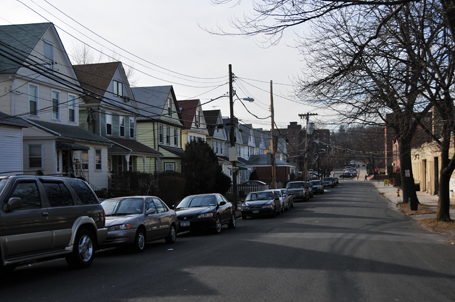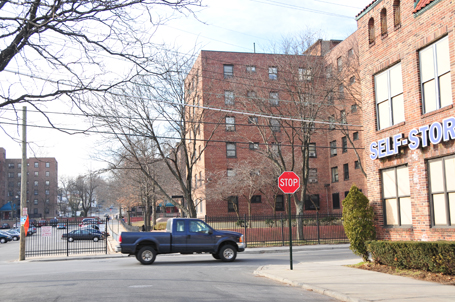
Lincoln School Desegregation Today (Part VII): The Plans and the Ruling
The photo above shows, left to right, Willene Murphy, Barbara Hall, Hallie Taylor, Marjorie Williams, and Eileen Hunter
Lincoln School Desegregation Today: Part I - Early Gerrymandering
Lincoln School Desegregation Today: Part II - The Dodson Report
Lincoln School Desegregation Today: Part III - Frustration Grows
Lincoln School Desegregation Today: Part IV - Civil DIsobedience
Lincoln School Desegregation Today: Part V - The Trial, Plaintiff's Case
Lincoln School Desegregation Today: Part V - The Defense Presents and Judge Kaufman Decides
We continue with Part VII...
John Kaplan wrote the following in his book Civil Rights USA - Public Schools Cities in the North and West 1962:
"In short, Judge Kaufman ruled that in 1930 the school board had gerrymandered the Lincoln district so as to withdraw a large portion of its white students, sending them to both the Webster and Mayflower schools; that between 1930 and 1934 the board had altered the boundaries of Lincoln so as to contain in the attendance area the ever increasing Negro population; and that until 1949 the school board had assured that the Lincoln school would remain Negro by allowing white students to transfer out of the zone. After 1949, when transfers were forbidden, the school board had adhered to the status quo and had left unchanged the situation which it had created by its own wrong. Accordingly, the board had a duty to remedy the situation and to present a plan whereby this would be done."
In his decision the Judge had also cited specific facts to prove that the school board had been operating in bad faith. These include: (1) the school board did nothing to improve the Lincoln situation; (2) the school board suppressed criticism, including the report by Theron Johnson; (3) the board rejected the Dodson recommendations; (4) the advertisement for the 1960 referendum campaign to rebuild Lincoln; and (5) the school board failed to discipline the principal's who spoke against integration in their schools.
New Rochelle Shocked
John Kaplan goes on "Judge Kaufman's decision shocked New Rochelle. The majority of the board's supporters, until the moment the decision came down, had considered it inconceivable that the judge would decide against them."
 |
| Houses on Winthrop Avenue |
People debated whether to appeal the decision. Some wanted to clear the reputation of New Rochelle, others wanted to save taxpayer's money. The board voted to appeal 6-3. It turned out that at the time the appeal was premature. The school board would have to submit their plan and hear Judge Kaufman's response.
The School Board Submits a Plan
The Board of Education submitted a plan under protest for open enrollment. It was not unanimously supported by the board. The plan did allow that the Lincoln students may register in any elementary school in New Rochelle, but it attached conditions. The conditions included: that seats must be available; class sizes must not be too big; students must have a recommendation from a Lincoln teacher and principal; students would have to pass qualifying tests; permission to transfer must be renewed each year; parents must pay for transportation; the board wanted additional flexibility. The board voted 6-3 in favor of the plan with minority members voting no. (NY Times, "New Rochelle Votes Plan for Integration", April 25, 1961).
On May 10th Judge Kaufman held a hearing on the plan. According to John Kaplan " In contrast to the previous proceeding in the Federal court, this hearing was conducted in an atmosphere of acrimony and bitterness." Attorney Zuber called 5 witnesses. One of the witnesses was Nolan Fallahay, school board member who did not support the majority votes of the board. He testified " that since the court's original opinion of January 24th, there had been "a complete freezing of knowledge" from the minority board members. Until that time "every instance in every case that the Lincoln School was discussed . . . even though I may have been a minority, I always received the information in advance and I was always treated in a gentlemanly fashion." This, he testified was no longer true."
 |
| Apartments - Winthrop Avenue & Brook Street |
On May 12th Judge Kaufman invited the Justice Department to submit "guidelines". Burke Marshall, Assistant Attorney General in Charge of the Civil Rights Section and US Attorney Robert M Morgenthau responded with a 16 page brief two weeks later.
The New Rochelle Board of Education's plan was rejected. A NY Times article from May 25th, 1961 called "US Submits Integration Guide for New Rochelle School Board" quotes the brief in the following: "The major defect was the provision that transfer requests from Lincoln be approved at three levels in the school system. Any one of the three persons … may block the request for transfer to another school ... Another provision that the Government found undesirable would require re-examination of the transfer from year to year … this would be a disruptive influence on the pupil and affect the child's feeling of security."
The Government's program suggested free transfers from the court-designated segregated schools … "In order to facilitate these permissive transfers, the board might be required to prepare and publish a list of vacancies in each grade of each school in New Rochelle. In any event, this court should retail jurisdiction to review complaints as to denials of requests for transfer." (NY Times, "US Submits Integration Guide for New Rochelle School Board", May 25, 1961)
New Rochelle School Ruling from Judge Kaufman
On May 31st Judge Kaufman decreed a completely free transfer for all Lincoln students, subject only to their being enough room in the receiving schools. He said "There is no room in the Constitution for any concept of inferior citizenship". The ruling was published on June 1, 1961 in the NY Times, "Text of the New Rochelle School Ruling". It orders that:
"(1) Commencing with the 1961-1962 school year, any child of elementary school age residing in the Lincoln elementary school district shall be permitted to register and enroll in any other public elementary school in the New Rochelle public school system."
" (2) On or before June 14 of this year and May 15 of each succeeding year, the Board of Education shall distribute to the parents of all children expected to be enrolled in the Lincoln School for the forthcoming school year transfer application forms which will: (a) set forth a list indicating the approximate expected number of vacancies in each grade in each of the other public elementary schools in the city for the forthcoming school year; (b) Provide an opportunity for the applicant to indicate at least four schools, in preferential order, to which transfer is requested; (c) include a notice that parents must provide any necessary transportation at their own expense; (d) include a notice that applications for transfer must be received by the official administering the plan no later than June 30 of this year, and June 1 in each succeeding year."
"(3) Admission of Lincoln School pupils shall be made only in accordance with the board's maximum class-size policy, provided that this maximum is not set below its present figure.
"(4) The board is not to impose any standard of academic achievement or emotional adjustment as a requirement for transfers.
"(5) Each pupil shall be retained in the school to which he has transferred until the completion of his elementary education, unless he becomes a resident of another school district.
"(7) The board is not required to furnish any transportation to pupils transferring in accordance with this decree.
"(8) The court shall retain jurisdiction over this case to assure full compliance with this decree."
 |
| Apartments - Winthrop Avenue & Brook Street |
In the next part of the series the implementation of the plan will be covered.
Lincoln School Desegregation Today (Part VIII): Counting Seats to Present Day